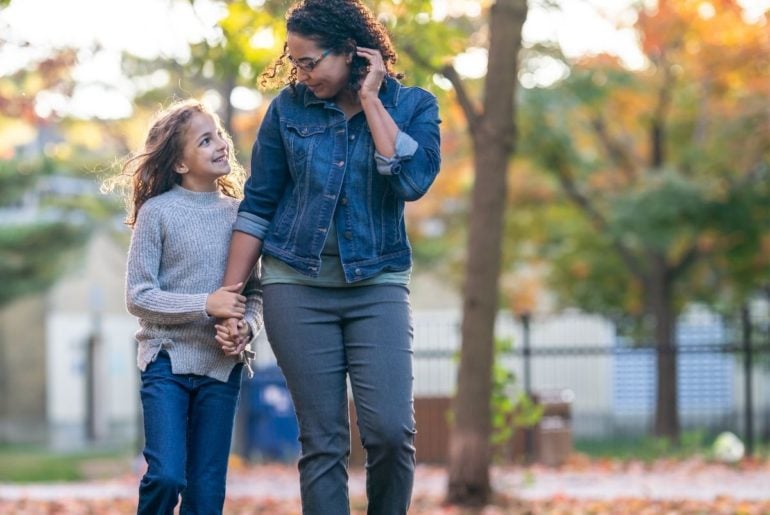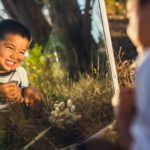The concept of global climate change might seem too scary or apocalyptic to share with kids right now. But while it might be unpleasant to think about, it’s also an extremely urgent topic—plus they’ll probably hear about it from school, the news, etc. and might already be feeling anxious.
Below is a guide to explaining climate change in kid-friendly ways, and helping kids feel empowered and hopeful about the future of our planet. Because they’ll be living on it!
Be real: climate change is serious
Don’t sugarcoat the issue or avoid it altogether, because climate change is already happening. Yes, it can be scary and overwhelming for kids (adults too!)—which is exactly why you have to educate them. Knowing what’s happening is the first step toward fixing it!
Start by making sure they know the basic facts:
“The oil, coal, and gas that humans use for energy are called fossil fuels. When these fossil fuels are burned (to run electricity, planes, cars, trucks, boats, factories, and more) they release a lot of carbon dioxide (CO2) emissions into the air.”
Expert tip: greenhouse activity
Climate scientist Shyla Raghav at Conservation International suggests showing kids a picture of a greenhouse or visiting a greenhouse to show how the glass traps the sunlight, making it hotter inside.
Explain that the “greenhouse effect” is what’s happening to our planet. Fossil fuel emissions combine with other “greenhouse gasses” that come from landfills, fields using certain fertilizers, destroyed forests, and other places. Together they trap sunlight in our atmosphere like a blanket, making Earth hotter. You can say…
“When the planet gets hotter it causes a lot of serious problems.”
“Too much ice melts at the poles, which causes oceans to rise and land to go underwater. The change in temperature causes more dangerous storms all over the world, too.”
“All of this can harm animals, plants, and humans, which is why humans need to stop climate change.”
Expert tip: explaining the scope
It can be tough for kids to grasp the enormous scope of climate change—but there are things you can do to help them understand.
Climate change experts Maria Ghiso and Jungwon Kim, of Rainforest Alliance, recommend talking about the difference between weather (changes in heat, wind, sunshine, rain, etc. from day to day) and long-term climate change (changes in average weather over 20-30 years).
Interview a grandparent or elderly friend about differences in climate they have observed in their lifetime to get a more personal perspective.
Spend plenty of time in nature
Don’t just talk about the environment, get outside and absorb it. Not only is outdoor time therapeutic, it also teaches kids about the environment and why they should care about it. It also shows them that “the environment” isn’t a faraway place, like the rainforests. It’s all around us, all the time.
Encourage kids to observe everything from ants on the sidewalk to the way trees change throughout the year. It’ll help them understand how everything on our planet is interconnected, and how our actions affect other living things.
Focus on hope and action
You can explain, “Climate change is a huge challenge for the planet that will take a lot of work to fix. But the good thing is that a lot of people care about climate change, and a lot of people are working hard to stop it.”
A few of hopeful examples to share:
- A group of youth called Our Children’s Trust is suing the federal government for supporting the burning of fossil fuels—and they’re being taken seriously by the courts.
- The use of renewable energy sources (wind power, solar power, and other alternatives to fossil fuels) is growing faster than other types of energy sources.
- Most Americans agree that the government should do more to fight climate change, and that the U.S. should develop more alternative energy sources.
Empower kids to do something about it
“Everyone can do their part to help reverse climate change. By picking some of these actions, sticking to them, and telling others about them, we can make a difference!”
Use clean energy: Get solar panels or a geothermal heating system, buy into wind energy, or ask local institutions and businesses to switch to renewable energy.
Buy local: When you buy food that’s grown close to home and products that are made locally, it helps reduce emissions that would be produced from the extra transportation by truck, plane, and/or boat.
Fly less: Travel by train, bus, or low-emission car when possible, or simply take fewer trips (perhaps staying in each place for longer instead) to cut down on flights.
Plant trees: Trees help reduce carbon emissions because they eat up lots of CO2 from the air during the process of photosynthesis.
Eat less red meat: Cows and other livestock release a lot of methane, which is a greenhouse gas. Plus, they inefficiently use up a lot of land—often land that used to be forests.
Buy less plastic: Most plastics are made from fossil fuels, plus they cause fossil fuel emissions as they are produced—and when they’re incinerated. Opt for non-plastic toys, and products that come in glass, compostable cardboard, reusable packaging, or simply less packaging.
Ask your child—Which of these things should we try doing first to help make the planet healthier?







